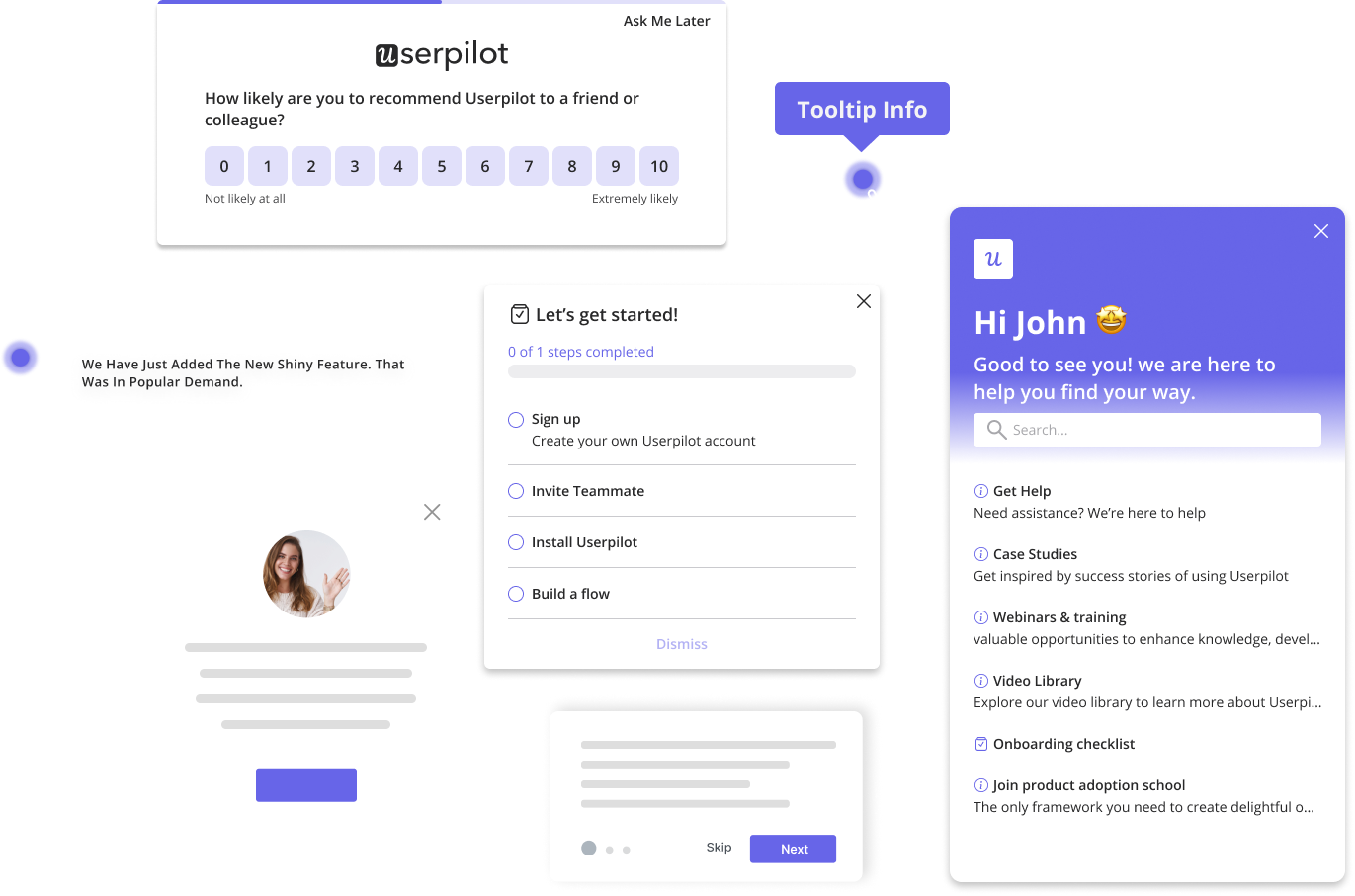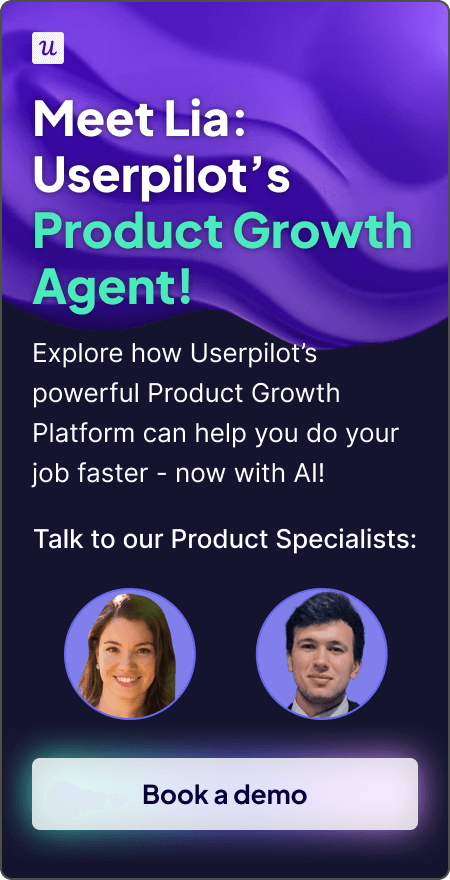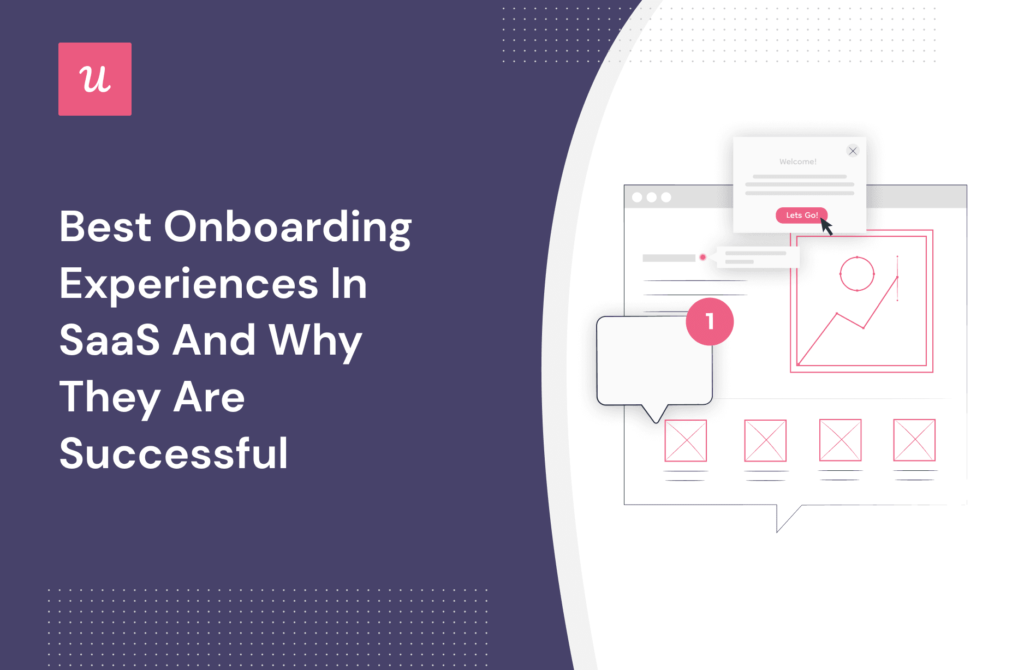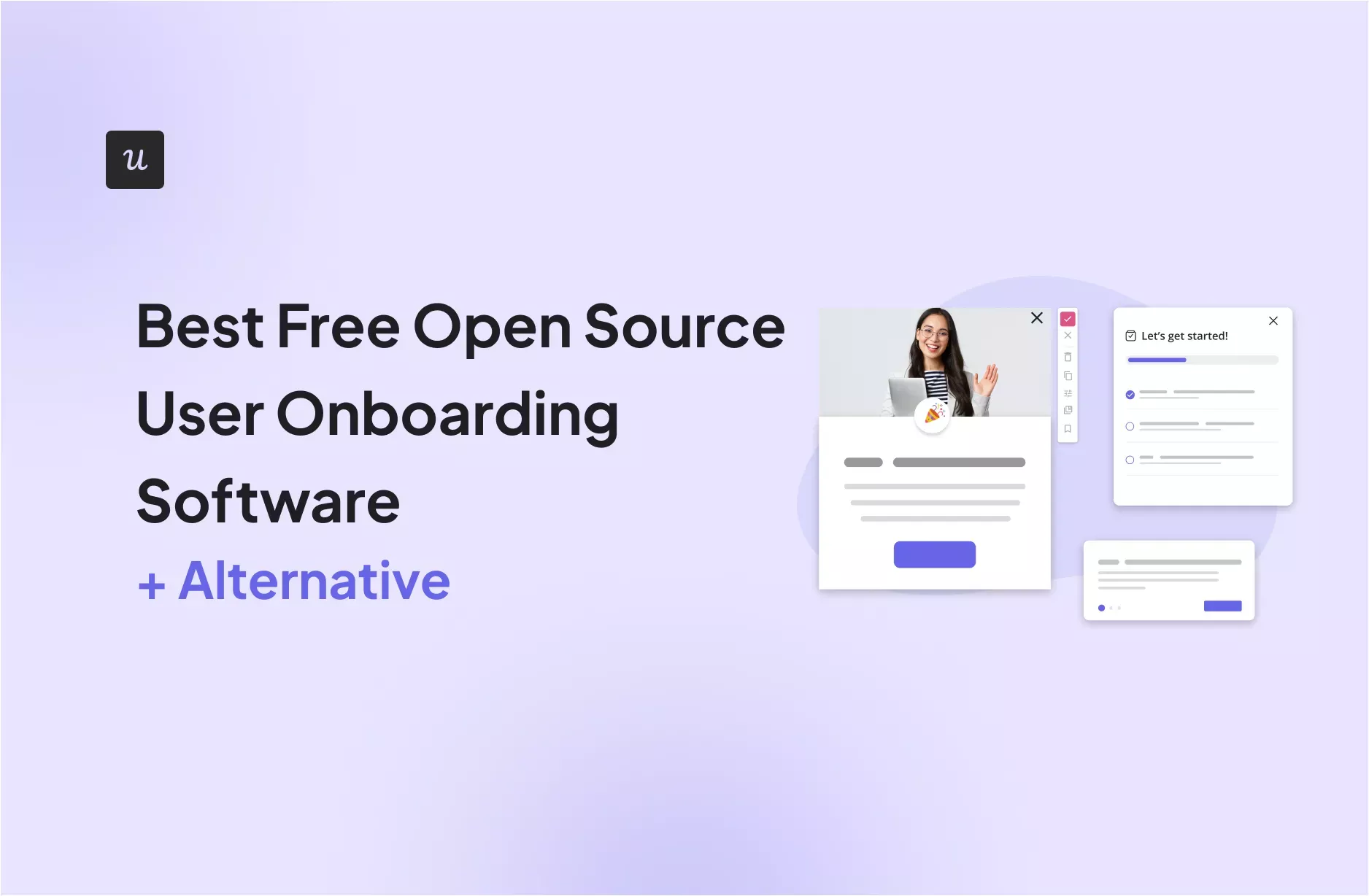
Every product needs some form of onboarding. Thus, many small teams look into open-source user onboarding software because it’s free and flexible enough to fit their needs.
But in my experience, open-source software is too easy to outgrow. Your success in using it depends on the complexity of your onboarding process and the developers’ availability to set up, scale, and update it. Plus, it doesn’t always end up completely free due to licensing and maintenance.
So let’s review 10 open source software for onboarding users and compare them with no-code onboarding software like Userpilot, starting with the definition.
Try Userpilot Now
See Why 1,000+ Teams Choose Userpilot
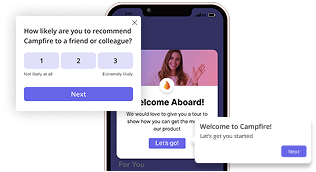
What is open source user onboarding software?
Open source user onboarding software usually means JavaScript/TypeScript libraries that you can apply to any app to build product tours, tooltips/hotspots, checklists, launchers, and simple modals. Since the source code is public, you’re free to modify and redistribute it as long as the project’s license allows it.
However, these tools are often built for one use case. They typically don’t include no-code editors, deep analytics, audience segmentation, A/B testing, or omnichannel engagement, meaning you’d still need separate tools for those use cases.
Why consider open source for onboarding?
As a product manager, there are three reasons I’d reach for open source first:
- Cost-effectiveness: The main benefit is that most open source tools come at no direct cost. However, keep in mind you’d still have to pay in engineering time for setup, QA, and ongoing maintenance. Also, not every open-source tool is free for commercial apps, particularly those with GPL/AGPL licenses.
- Customization and flexibility: Since you have full access to the source code, you can customize step logic, styling, targeting, and even how the product tour reacts to app state. This gives you full control to personalize onboarding experiences as long as you have the engineering resources to invest.
- Community and collaboration: Popular platforms usually have a community of contributors who fix bugs, add features, and answer issues, available to support you in solving compatibility problems or applying specific use cases.
How much developer time are you spending on your open source user onboarding solution?
How easily can non-technical team members (PMs, Marketers) create or update onboarding flows?
Can you personalize onboarding for different user segments without custom code?
How do you measure the effectiveness of your onboarding (e.g., A/B testing, analytics)?
It looks like you’re outgrowing your open-source solution.
Stop sinking developer time into a clunky open source user onboarding process. Userpilot’s no-code platform lets your whole team build, test, and personalize user onboarding in minutes, not months.
10 Best (and free) open source onboarding software
If you want to implement in-app guidance via open source, these JavaScript/TypeScript libraries are your best starting point.
I’ll break each one down the same way (what it is, key onboarding features, and pricing notes) so you can pick the right fit for your stack.
1. INTRO.js
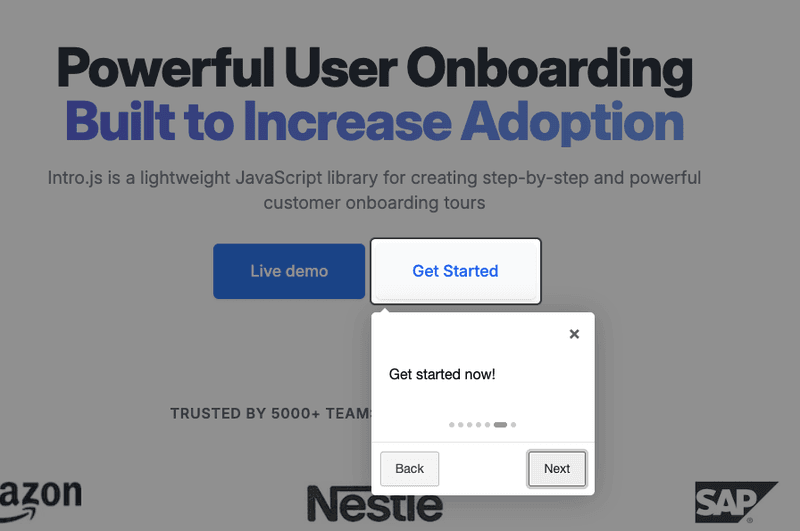
Intro.js is a lightweight, framework-agnostic JavaScript library for step-by-step product tours. It’s good for a quick “show me around” without pulling in heavy dependencies.
While the platform is popular, its GitHub community is no longer active. Updates are infrequent (only bug fixes), and there’s a big backlog of open issues.
Key features:
- In-app guides: It includes tooltips and modals with a dimmed backdrop and step controls (Back/Next/Skip).
- Progress UI: Intro.js lets you add dots or bars to show progress in multi-step tours.
- Multiple wrappers: It can integrate with Angular, React, R, Vue, Blazor, Dart, etc. Plus, there are no external dependencies, meaning you just need to drop it in JS and CSS to run it.
- Simple API: Its API makes it easier to define steps, customize design, set up programmatic controls, etc.
As for pricing, Intro.js is AGPL-3.0 for open-source/non-commercial use. For commercial apps, you must buy a commercial license (lifetime, one-time), which includes Starter $9.99 (1 project), Business $49.99 (5 projects), and Premium $299.99 (unlimited).
2. Shepherd.js
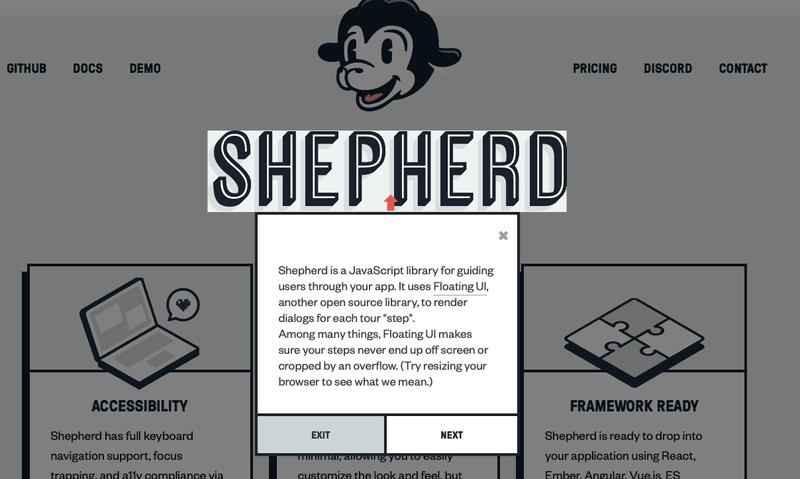
Shepherd.js is a framework-friendly tour library that supports framework wrappers such as React, Vue, Angular, or vanilla JS. The project still has frequent releases, GitHub issues/discussions, and a dedicated Discord for help.
Key features:
- Simple in-app guides: Shepherd.js includes simple tooltips with “next” buttons.
- Floating UI: It uses Floating UI to prevent overlays from showing out of placement, colliding, or appearing offscreen.
Shepherd.js is free for non-commercial sites. For commercial apps, you need a paid lifetime license, including Business (at $50) or Enterprise (at $300).
3. UserTour
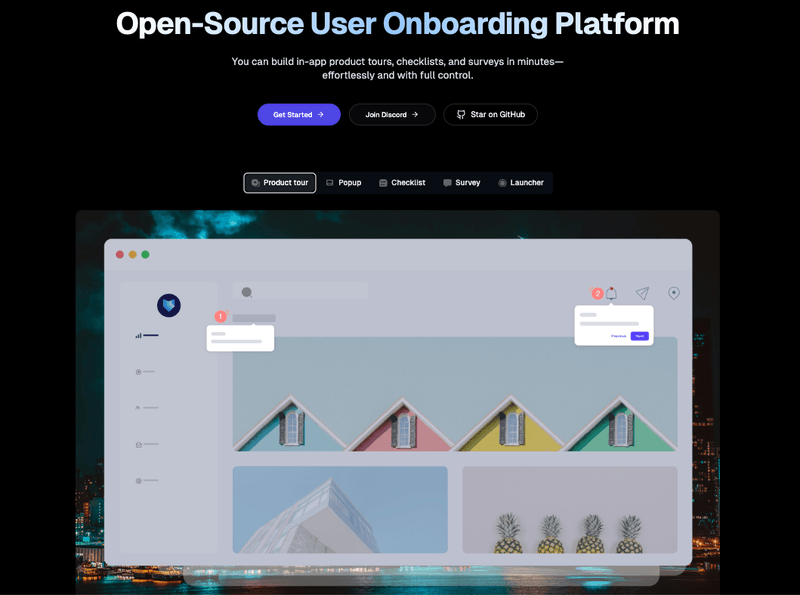
UserTour is an open-source, self-hostable onboarding platform that goes beyond a simple library. It supports all frameworks and lets you self-host it via Docker.
Key features:
- Visual builder: UserTour has a WYSIWYG editor where you can customize product tours, checklists, surveys, and launchers to match your product’s UI.
- Basic analytics: It tracks the completion rates of your onboarding flow and lets you explore their individual journeys.
- Multi-page app support: You can implement the same onboarding flow on different pages.
- Personalization: UserTour can trigger personalized onboarding flows based on in-app events or website visitors. Plus, it supports multi-language localization.
Any commercial product should use the vendor’s commercial license or hosted tiers. Current pricing plans for cloud include Hobby for free, Starter at $59/month, Growth at $119/month, and Business $249/month. However, you’d need to pay extra for more sessions and data retention, which can turn it into an unnecessarily expensive product.
Alternatively, you may opt for the self-hosted option, which costs $2,988/year for commercial apps.
4. React Joyride
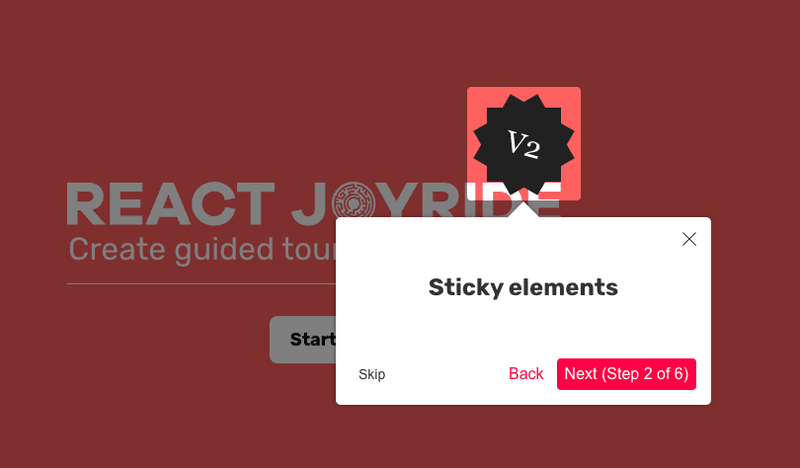
React Joyride is a React-first library for creating step-by-step product tours with a smooth setup process. However, there’s been decreased activity in the GitHub community, with the last update being in 2024.
Key features:
- Onboarding tours: You can implement tooltips with Back/Next buttons, Skip and Progress indicators, optional overlay/spotlight, and scroll‑into‑view helpers to keep targets visible.
- Positioning reliability via React-floater: React Joyride offers smart placement and collision handling that works across nested layouts and long pages.
- Localization: You can customize button labels and text to support multiple languages and RTL.
- Multiple themes: The library supports custom style attributes (colors, spacing, z‑index) to match brand guidelines.
React Joyride is MIT-licensed, which means it’s free for personal and commercial use with no paid plans.
5. TourGuide JS
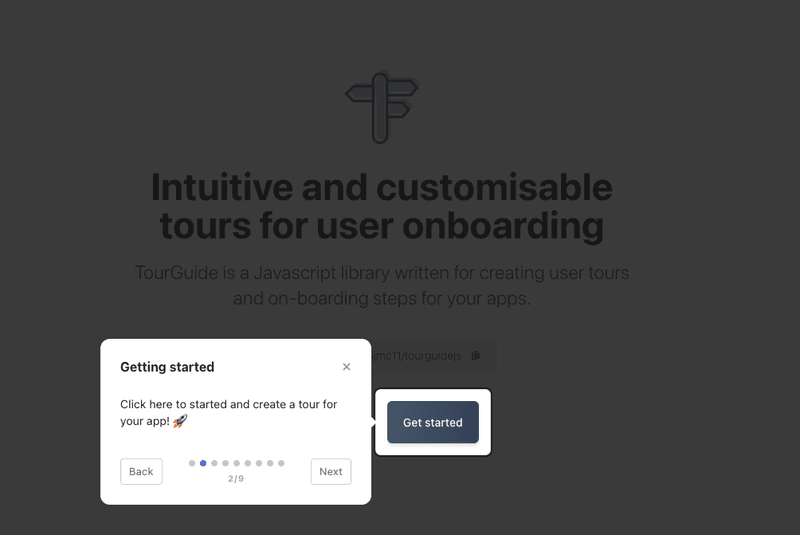
TourGuide JS is a lightweight, framework-agnostic onboarding library you can use in any web app to build simple tours. Its community is still active, with the latest release in May 2025.
Key features:
- Product tours: The library includes tooltips with “next”, “skip”, or “back” buttons, and customizable design (including content, size, and placement).
- Floating UI positioning: The platform makes sure to keep tooltips visible and correctly placed.
- TypeScript types: It lets you configure the product tour’s properties, as well as the structure of each step (the target element, the HTML content, etc.).
TourGuide JS is MIT-licensed, meaning it’s free for personal and commercial use with no paid tiers.
6. Onborda
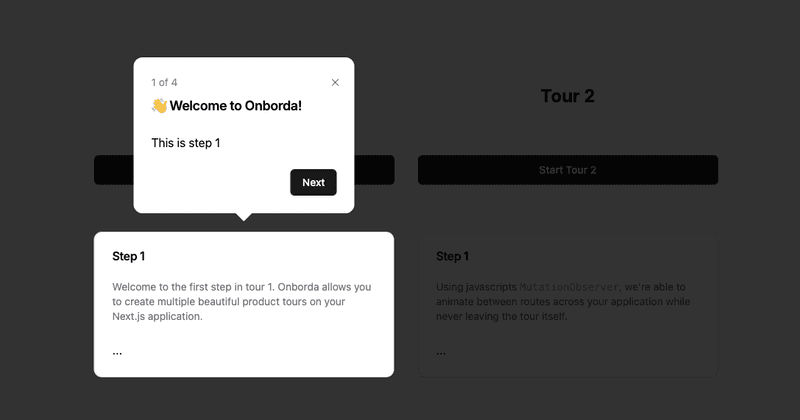
Onborda is a modern, Next.js-based onboarding platform. It can build tooltips and wizard-like tours animated with Framer Motion. As for activity, the project is relatively new (with the latest release on Dec 22, 2024) and has a small maintenance group.
Key features:
- Multi-page and multiple tour support: You can set up more guides at once, on different pages of your app.
- Custom cards: You can fully brand the tooltips’ and cards’ UI.
- Tailwind for styling: It can override colors, spacing, radius, and typography, or swap in Card components (which lets you customize the header, body, and CTA layout of the tooltips).
Onborda is MIT-licensed, so it’s free for personal and commercial use.
7. Driver.js
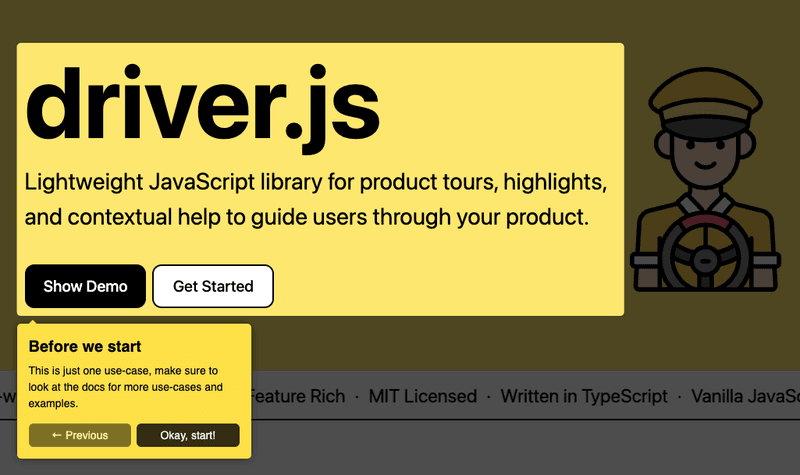
Driver.js is a library that can “spotlight” elements and run animated product tours. It’s written in TypeScript, is framework-agnostic, and it’s highly customizable. Although there are still some old open issues on GitHub, it’s still popular and has received recent releases this year.
Key features:
- Customizable tours: Beyond adding tooltips or popovers, Driver.js can also dim the page to highlight UI elements, which adds more use cases. It lets you animate transitions between steps, highlight elements (by dimming the page), show progress, control buttons, and more.
- Simple API: The library has zero dependencies and is super small in size (about 5 kb gzipped), so it fits into basically any stack.
It’s MIT-licensed, meaning it’s free for personal and commercial use, with no paid tiers.
8. Crumble
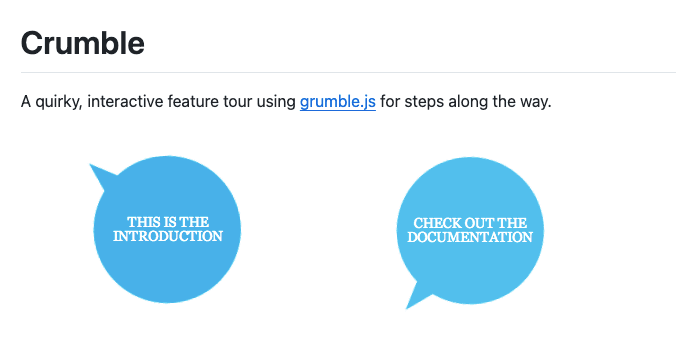
Crumble is a jQuery plugin for simple feature tours. It’s lightweight, easy to wire up, and it’s good for single-screen walkthroughs. However, it hasn’t been updated in years (last commits from 2012), has no releases, and depends on jQuery. This means you’ll likely hit compatibility gaps in modern stacks.
Key features:
- HTML-based code: Instead of composing steps in JS, you define them right in your HTML as an ordered list, and Crumble turns each list item into a tooltip “bubble” that points at a target element.
- Simple bubbles for product tips: The grumble.js-powered bubbles include Back/Next steps with basic callbacks (onStart, onStep, onFinish) and let you make minor customizations, such as the angle of the tooltip arrow around the element.
Crumble is MIT-licensed, so it’s free for commercial use.
9. Guidefox
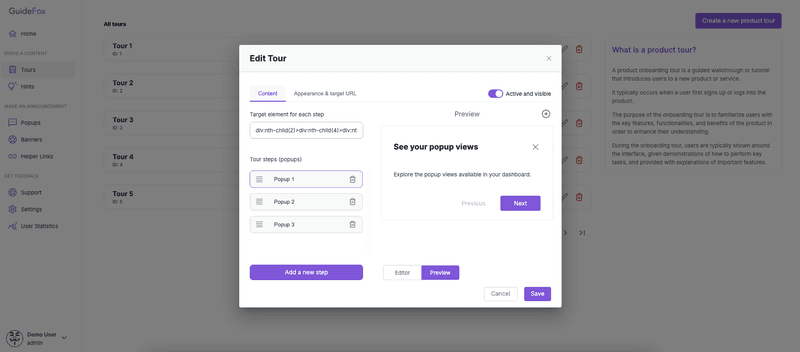
Guidefox is a self-hosted, open-source onboarding tool that’s new and still in constant development. It’s made to run on Docker and has a user-friendly UI where you can customize the onboarding experiences visually without coding.
Key features:
- Welcome tours with multiple UI experiences: It includes hints, helper links, popups, banners, and interactive tours.
- Performance metrics: Guidefox shows how many users viewed your guides month by month.
- Feedback features: Its interactive forms allow you to send surveys inside your app to collect contextual feedback.
Guidefox has an AGPL-3.0 license, which lets you use it commercially as long as you make any modifications public.
10. OnboardJS
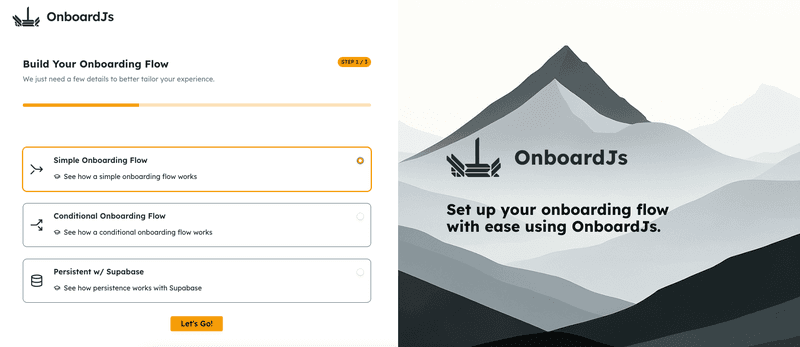
OnboardJS is a headless onboarding engine for React/Next.js apps that’s still new and receiving consistent updates on GitHub. It focuses on wizard UIs, which are mostly used when the user signs up for your product (no new feature tours, announcements, banners, spotlights, etc.).
Key features:
- Headless for React/Next.js apps: You can use OnboardJS with your own frontend. And since it’s built with TypeScript, its API is very straightforward to use.
- Wizard-like welcome flows: It lets you fully customize onboarding steps, add conditional logic, and set up dynamic navigation. This lets you build contextual onboarding flows that adapt to user behavior.
- Integrations with third-party tools: It integrates with Posthog, Mixpanel, and Supabase so you can get actionable insights about your onboarding process and improve activation.
It’s MIT-licensed, meaning it’s free for commercial use.
Where open source falls short for onboarding
Open source can be cost-effective and flexible, but it comes with trade-offs:
- Heavy coding and dev time: Even with simple libraries, you still have to wire events, handle routing edge cases, style tooltips, and perform QA across browsers. This requires engineering time, which undermines the economic benefit of using open source licenses.
- Maintenance burden: Open-source tools aren’t “set it and forget it.” They need framework updates, router changes, design refreshes, and continuous adjustments as your product changes. Plus, if any of these libraries get abandoned, they’ll eventually become too outdated for your stack.
- Limited out-of-the-box capability: Most of these platforms don’t go beyond in-app onboarding guides. There’s no built-in segmentation, A/B testing, deep product analytics, or omnichannel engagement tools. This means you’ll need to build separate tracking mechanisms and dashboards.
- No dedicated support: When something breaks or you need help with a complex use case, you’re often left to community forums or your own team’s troubleshooting. There’s no dedicated support team to lean on, which can be a huge time sink if the community isn’t active.
- Scaling complexity: As your user base grows and your product evolves (multiple roles, environments, locales, and feature flags), open-source solutions become hard to manage. Maintaining consistency across different versions of your app or setting up dynamic content requires significant effort.
The Userpilot approach: Scalability, control, speed
I believe open-source solutions are good for small projects or when you don’t need a sophisticated onboarding process. But for growing products, maintaining and integrating them in an ever-changing tech stack isn’t convenient.
That’s why I prefer an all-in-one product growth platform like Userpilot. Here’s why:
No-code onboarding for rapid iteration
Since Userpilot is 100% no-code, onboarding iterations are faster. I can design complex user onboarding flows, create interactive walkthroughs, and use a wider variety of UI patterns (like checklists). Then, using the Chrome extension, I can select any element on the page and build an onboarding guide around it, all without touching HTML.
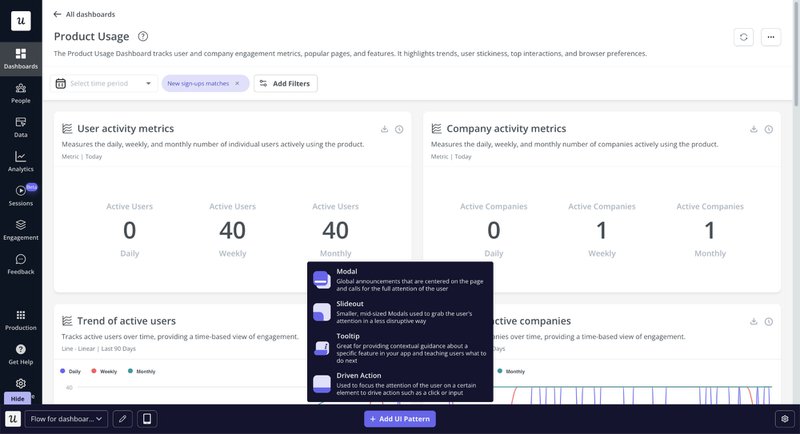
Moreover, I get access to pre-built templates or build my own, which helps me keep branding consistent across tours and reuse components instead of rebuilding from scratch. Plus, if the copy needs polishing, the AI assistant can write multiple iterations fast.
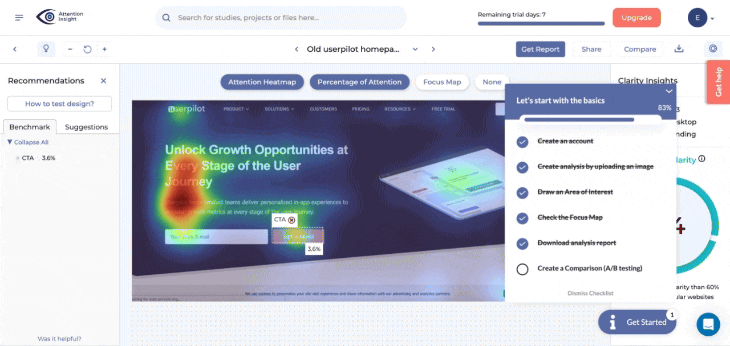
And most importantly, even if our product UI changes or gets a rebranding, I won’t need to ask engineers to rewire and update our onboarding flows.
All of these allow us to iterate onboarding processes faster, while engineers can get more time to focus on the core products.
Comprehensive in-app guidance beyond product tours
Onboarding is not a linear process. Users tend to deviate from the happy path and get stuck, which is when they need access to support.
With Userpilot’s in-app resource center, users have easy access to self-serve help without leaving the product. This includes links to our knowledge base, video tutorials, search bars, onboarding flows, webinars, and human support.
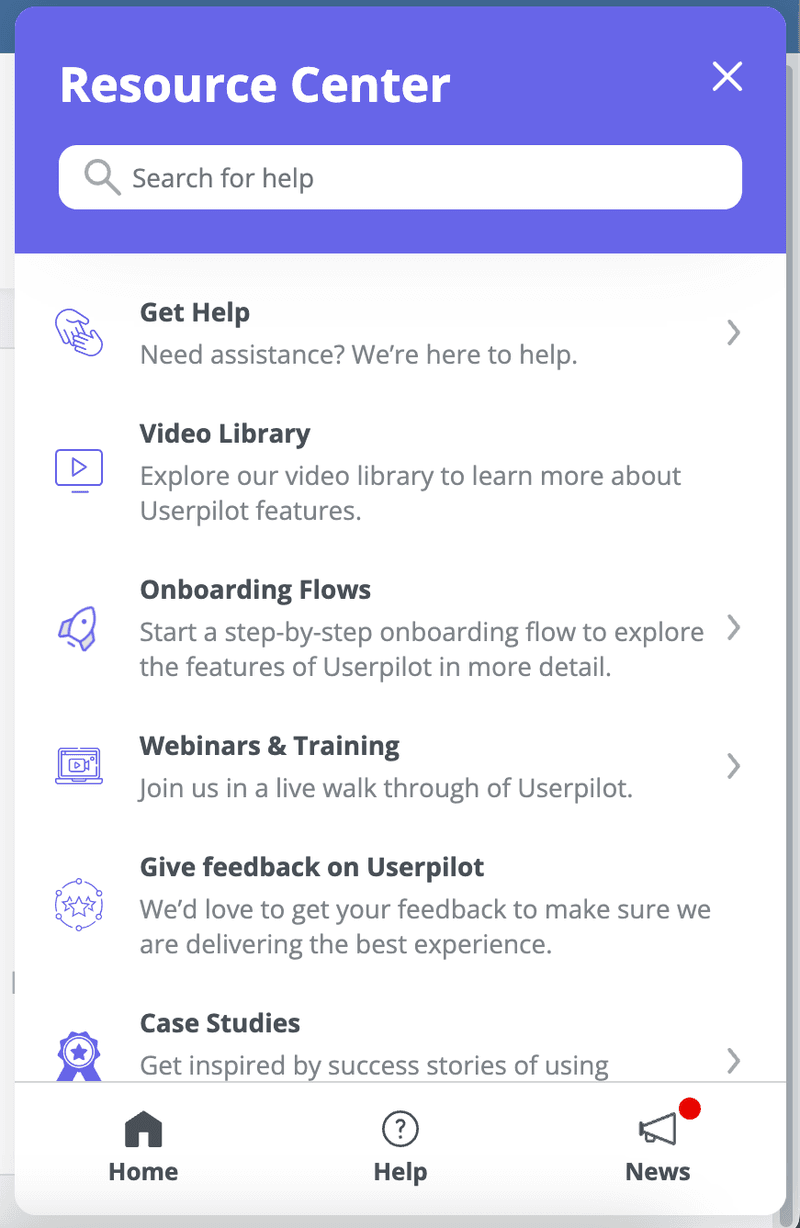
Surveys for gathering user feedback
With Userpilot, I can trigger in-app surveys when a user completes an onboarding flow to collect relevant user feedback. This can involve CSAT surveys to measure customer satisfaction, CES for tracking usability, and NPS surveys for general loyalty.
Additionally, since Userpilot integrates feedback with engagement, I can create segments based on survey responses. For example, I can create a group of NPS detractors and then target a re-engagement email to win them back.
This allows me to close the customer feedback loop and continuously improve our onboarding experience.
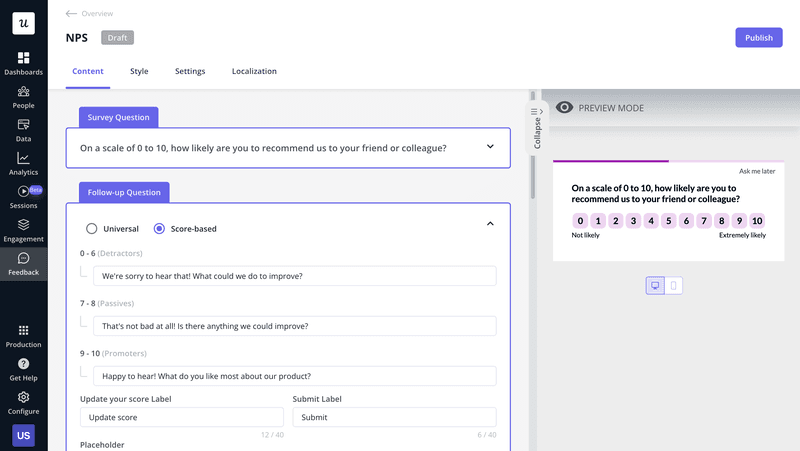
Omnichannel experience: Mobile and email support
Unlike most open-source software, Userpilot can target onboarding flows to the same segment across channels, including web apps, email, and mobile. This helps reach the right users at the right time and create coherent communication flows.
For example, if a new user only followed half of the in-app onboarding steps before dropping off, I can set up an automated email that nudges them to return to the product and complete the onboarding.
In the same way, I’m able to trigger push notifications to mobile users when their trial is about to end or if there’s a new feature to try out.
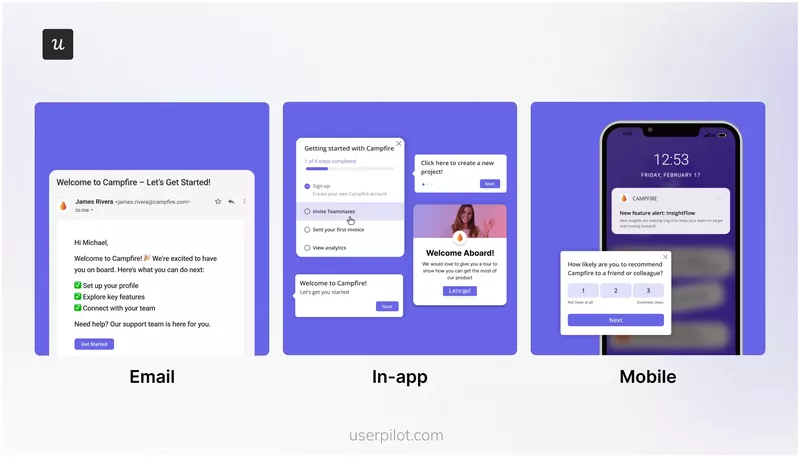
Deep user behavior and product analytics
I can’t improve onboarding if I can’t see how users interact with our product.
When using open-source software, I’d have to install separate tools to set up events (which often require dev help) and find workarounds to pull reports from siloed data.
With Userpilot, I get all data in one place, including the performance of my onboarding flows, behavioral data, and survey responses. This lets me find correlations and patterns in one place without importing data from the warehouse manually.
Here are some of the report types and tools I use with Userpilot:
- Funnel analysis: Illustrates how users move through a pre-defined funnel (e.g., showing activation steps from signup to activation). It helps spot drop-offs and gauge the efficiency of onboarding or product tours.
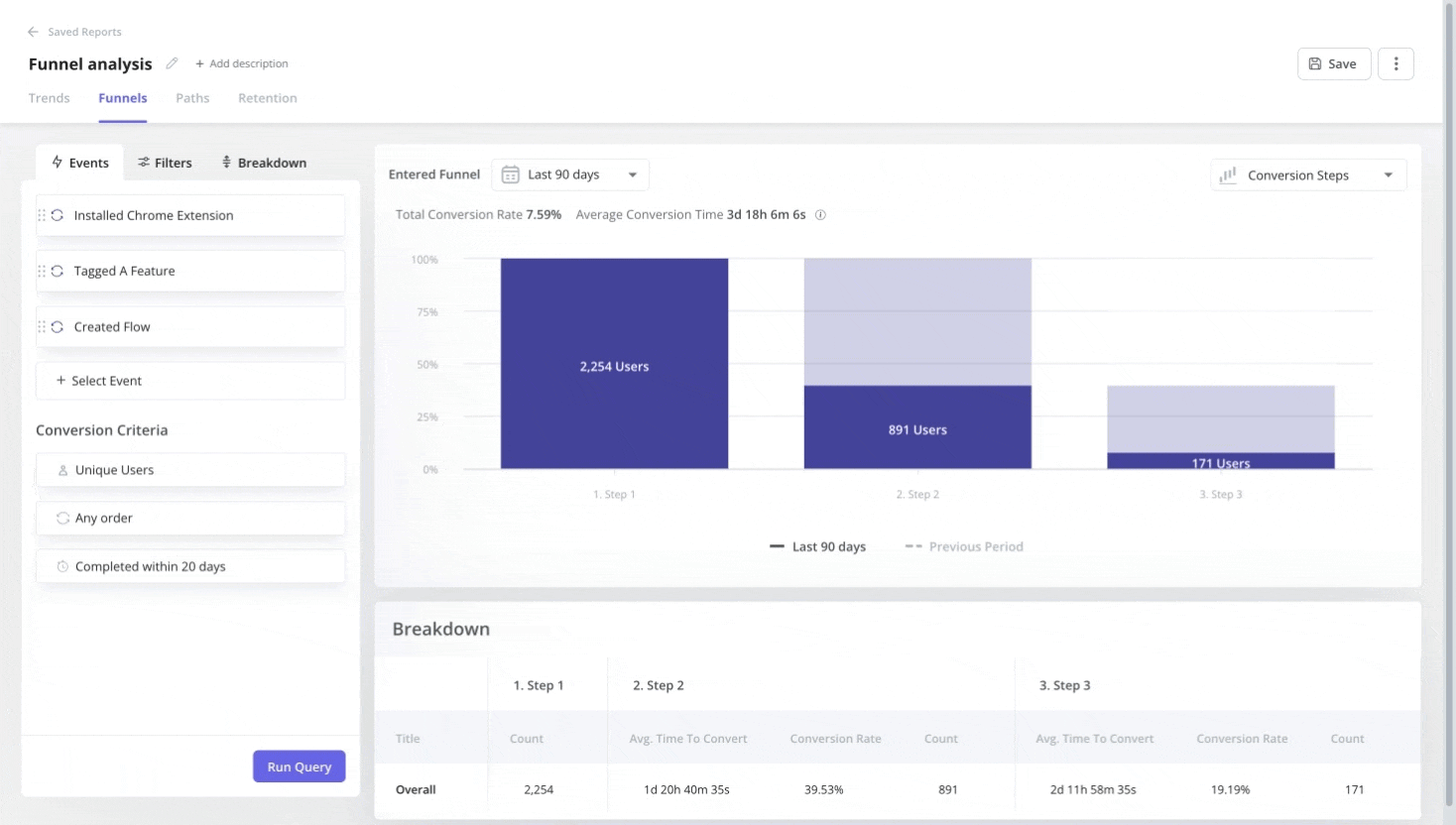
- Path analysis: Shows how users navigate the app from a starting point, illustrating how they diverge into different paths. It helps me figure out the happy path for onboarding.
- Custom dashboards: Adds all the onboarding metrics I need in one place, including MAU, active companies, feature usage, and cohort/retention graphics. Plus, I can filter by plan, role, lifecycle stage, or any user segment to get deeper insights.
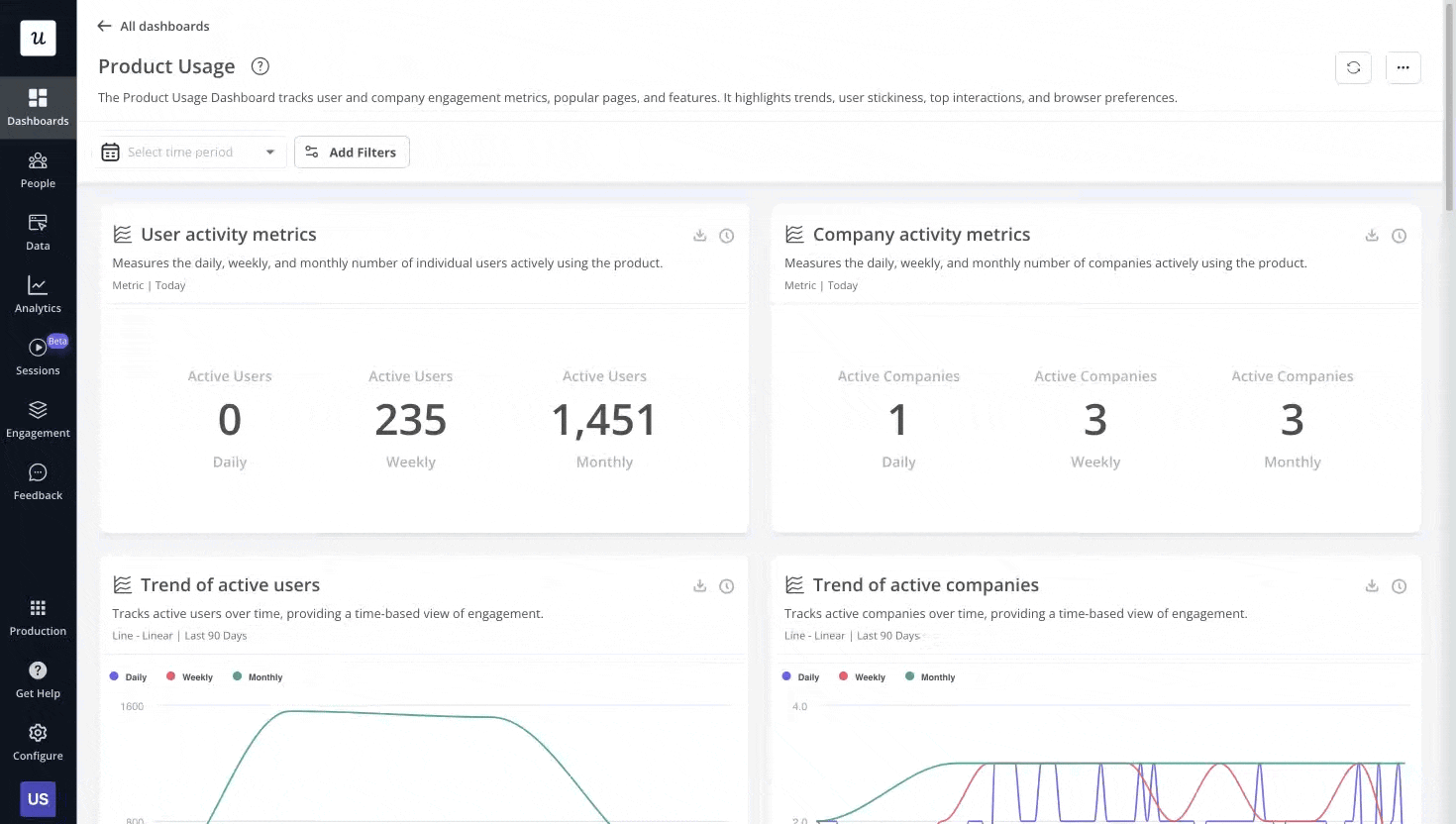
- Session replays: Session replays replicate exactly how new users interact with our product in a video format, allowing me to watch the product experience from the user’s point of view. They let me find bugs, usability issues, and opportunities to improve the onboarding process.
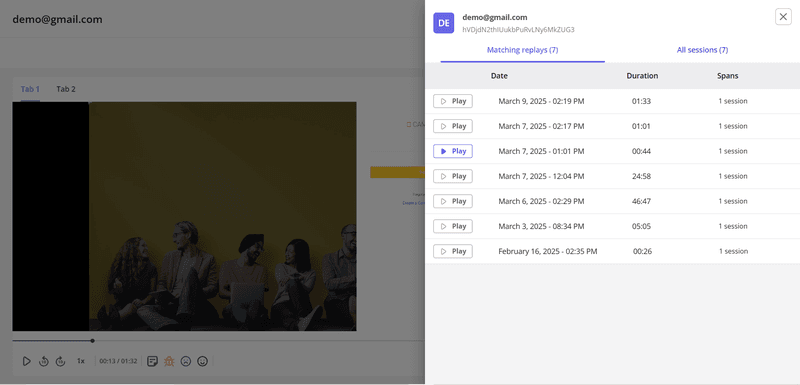
Targeted and personalized experiences
Userpilot allows me to segment users based on their properties or in-app behavior and deliver contextual onboarding. I can greet users by name or tailor content to their specific JTBDs, creating a more relevant product experience. I can also trigger messages to send automatically based on the users’ in-app actions.
And since Userpilot supports autocapture, all interactions are automatically tracked after labeling, which means that setting it all up requires no engineering effort.
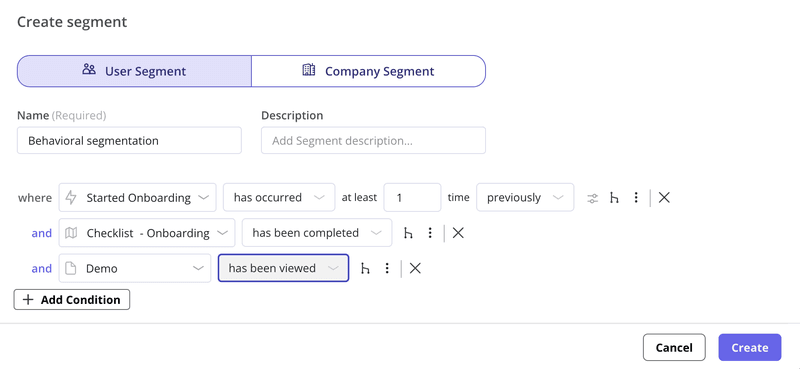
Plus, I can use Userpilot’s localization features to translate our content based on the user’s location, no matter their language.
Continuous testing and optimization
Your onboarding process isn’t set-and-forget. It needs constant testing.
With Userpilot’s built-in A/B testing for flows and real-time data, I can continuously refine my onboarding strategies based on what truly drives product adoption and reduces user friction.
I can perform three types of experiments, including:
- Controlled testing: For testing the performance of one flow versus having no flow.
- Head-to-head testing: For comparing the performance of two different flows.
- Multivariate testing: For finding the most optimal combination of buttons, headings, UX copy, and placements to optimize performance (Warning: requires a bigger sample size).
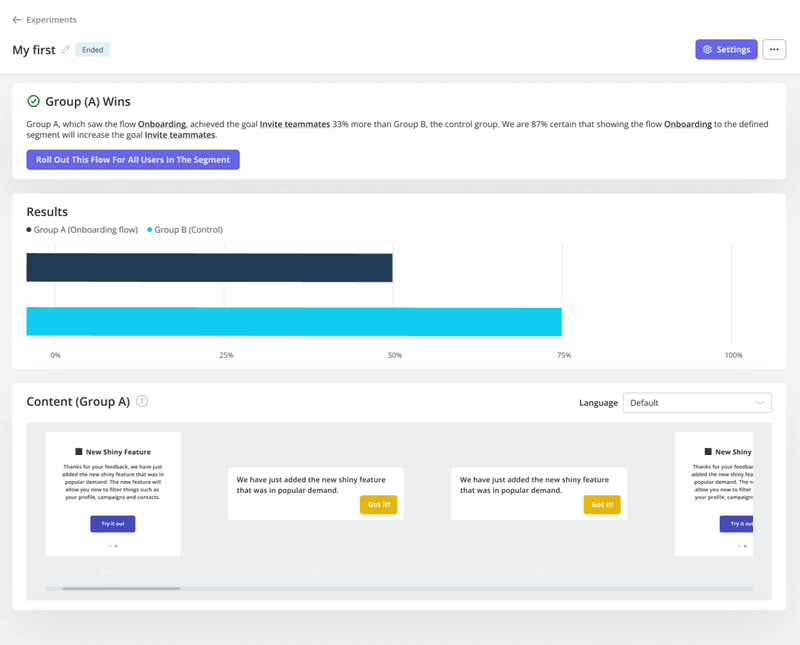
Integrations and security
Finally, the biggest issue with most open-source software is limited integrations.
Userpilot integrates seamlessly with existing tech stacks, from CRMs like HubSpot and Salesforce to analytics tools like Segment and Google Analytics. Plus, the webhooks and APIs let me push key outcomes (e.g., “Checklist completed”) back into the CRM or data warehouse.
It also provides robust security features, including Content Security Policy (CSP) support and the ability to set up production and staging environments.
Set up a scalable product onboarding process with Userpilot
As I’ve mentioned, open source user onboarding software is a simple solution for basic needs or if your project is small.
But if your company aims to grow significantly every year and you need to iterate fast, a no-code platform will save engineering hours, provide faster experiments, and make onboarding easier.
Want to get started with Userpilot for free? Book a demo today and ship your first onboarding flow in minutes.

